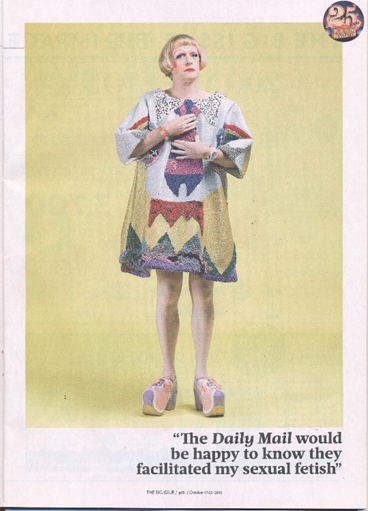The Big Issue Representations: Van Zoonen
- Nick Saward
- Nov 3, 2023
- 2 min read
The Big Issue prides itself on providing a fair and balanced representation on social groups whilst providing a voice for the voiceless.
Van Zoonen states the idea that gender is constructed through discourse and it varies according to cultural and historical context


The article about Grayson Perry which is about his past experiences and one of his experiences was that he struggles with masculinity and dysfunction but also wearing his mothers and stepmother’s clothes. After the article we see this picture which we can assume is him. The article does goes against stereotypical views on gender as we can see that he is interested in wearing more feminine clothing and wearing makeup, this article is based Grayson’s life experience so it was from 1976 which back then it wasn’t common and socially acceptable for a man to look like that but it is more acceptable now so was properly why Grayson never talked about it much an this can be still seen as a bit taboo as it was definitely in the 70s. It does support that historical and social context does vary in meaning as we know today people are more open minded compared to back in the 70s and this means for the magazine is able to talk about this more openly therefore giving a voice to this community who were likely to be shamed and kicked out for.
We can see through the article that the use of copy and images allows The Big Issue to brake stereotypes of gender. As the use of the wig, type of dress and make up breaks the idea that this is for women only as they have a picture of Grayson from maybe now or back then to break the binary ideas seen in mainstream magazines.
The Big Issue portrays both men and women as equal and not treated like objects throughout publication. Part of Van Zoonen's theory says that the display of women's bodies as objects to be looked at is a core element of western patriarchal culture however this doesn't necessarily apply to The Big Issue as women are also able to share their own stories on their experience with like homelessness. the representation of women throughout the magazine is positive and are not objective with other magazines sometimes to.
However we do see an advert for knitting which is to support the vendors. This can be seen as stereotyping women as doing these types of activities as we can only see the back of woman in the advert. Can also be reinforcing the ideology of knitting being a women’s hobby and something men would not usually enjoy as we don’t see any one else except were to by the material but the majority of the audience could be women who enjoy knitting which therefore it could be reaching and drawing this audience in.



Comments